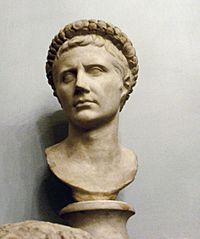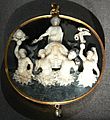Roman emperor facts for kids
Quick facts for kids Emperor of the Roman Empire |
|
|---|---|
|
Imperial
|
|

Vexillum
|
|

Augustus
|
|
| Details | |
| Style | Imperator, Augustus, Caesar, Princeps, Dominus Noster, Autokrator or Basileus (depending on period) |
| First monarch | Augustus |
| Last monarch | Theodosius I (Unified or Classical), Zeno (Unified), Julius Nepos (Western), Constantine XI (Eastern) |
| Formation | 16 January 27 BC |
| Abolition | 17 January 395 AD (Unified or Classical), 22 June 480 AD (Western), 29 May 1453 AD (Eastern) |
| Pretender(s) | None |
The term Roman Emperor is used by historians to describe the rulers of the Roman Empire. This was after the period known as the Roman Republic. In ancient Rome, there wasn't one single title like "Roman Emperor." Instead, it's a simple way to talk about a complex set of jobs and powers.
Historians often have to decide how to describe these rulers. This is because the Romans themselves didn't think about "empire" or "emperor" in the same way we do today. The Roman Empire kept many of the old political ways from the Roman Republic. This included the Senate and public meetings called assemblies.
Roman Emperors were not always the true rulers. Sometimes, they were just a public face. Powerful officials, women, or generals often held the real power behind the scenes.
Contents
Understanding the Roman Emperor's Role
The Roman Emperor was not like a king who inherited their power. Their position was a mix of different jobs. These jobs gave them a lot of control over the Roman world.
How Emperors Gained Power
Becoming an emperor was not always simple. Sometimes, the Senate chose them. Other times, the army played a big role. Emperors often had to be strong leaders. They needed to keep control over a vast empire.
The Emperor's Daily Life
Emperors lived in grand palaces. They had many servants. Their days were filled with meetings and decisions. They managed the army, laws, and money. It was a very busy and important job.
Key Roman Emperors and Their Impact
Many emperors shaped Roman history. Some were known for their wisdom. Others were known for their military strength. Each emperor left their mark on the empire.
Augustus: The First Emperor
Augustus is often seen as the first Roman Emperor. He ruled from 27 BC. He brought a long period of peace. This time was known as the Pax Romana. Augustus set up many of the systems that later emperors used.
Famous Emperors and Their Legacies
Other emperors like Constantine the Great changed the empire's religion. He made Christianity accepted. Theodosius I was another important emperor. He made Christianity the official religion. The empire later split into Western and Eastern parts.
The Last Emperors
The Western Roman Empire ended in 476 AD. Its last emperor was Julius Nepos. The Eastern Roman Empire, also called the Byzantine Empire, lasted much longer. Its last emperor was Constantine XI. He ruled until 1453 AD.
Images for kids
-
A beautiful cameo showing Augustus in a quadriga (a two-wheeled chariot). It is pulled by tritons. This artwork is in the Kunsthistorisches Museum.
-
This 1st-century Sardonyx cameo shows an eagle. The eagle was a symbol of Jupiter, a main Roman god. It is also in the Kunsthistorisches Museum.
-
An imagined portrait of Constantine XI. He was the very last Roman emperor of the Eastern Roman Empire.
-
Charles V was the last emperor of the Holy Roman Empire to be crowned by the Pope.
See also
 In Spanish: Emperador romano para niños
In Spanish: Emperador romano para niños







